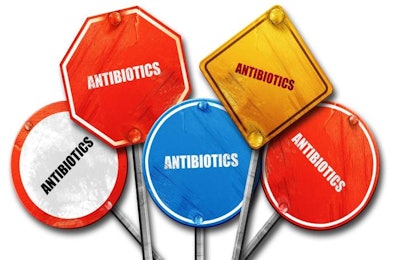
There is a consensus in the animal agriculture and veterinary communities that supports the judicious, legal use of antibiotics to prevent, control and treat disease, according to representatives from several organizations who spoke at the Public Meeting of the Presidential Advisory Council on Combating Antibiotic-Resistant Bacteria (PACCARB) in Washington on Wednesday.
The panel, which was moderated by PACCARB Vice Chair Lonnie King, comprised:
- Dr. Thomas Meyer, American Veterinary Medical Association
- Dr. Andrew Maccabe, Association of American Veterinary Medical Colleges
- Dr. Fred Gingrich, American Association of Bovine Practitioners
- Dr. Locke Karriker, American Association of Swine Veterinarians
- Jeffrey Simmons, Elanco Animal Health
- Dr. Richard Carnevale, Animal Health Institute
The panel discussion was meant to take a broad look at antimicrobial resistance (AMR) in animal production.
Several panel members reiterated the fact that antibiotics keep animals healthy and, therefore, the food supply safe.
“Healthy animals make healthy food,” Meyer said.
Simmons agreed: “Healthy animals make healthy people as well as a healthy environment,” he said.
Simmons also pointed out the difference between the elimination of antibiotics and the judicious use of them.
“Responsible use does not mean eliminating use,” he said. And, to that point, “eliminating antibiotics does not mean eliminating disease.”
He explained that untreated sick animals would cause a greater human health risk than treating sick animals with antibiotics and that, if all medicines were removed from animal production, more animals would experience clinical illness.
“Antimicrobials are an important part of a veterinarian’s tool kit,” Meyer said. “Antibiotics, when used properly, can save lives.”
Carnevale echoed that by explaining that the veterinary community tries its best to prevent disease with vaccines, but antibiotics are still needed when disease prevention isn’t enough. He and Simmons agreed that the animal health community still needs to develop new, novel vaccines, antimicrobials and alternatives to keep America’s production animals healthy.
“If we could achieve adequate animal health without antimicrobials, that would be a desired outcome. But we have to have some science-based mechanism to ensure animal health,” Karriker said.
Labeling foods ‘antibiotic free’
Carnevale addressed what he called the “disturbing trend” toward promotion of antibiotic-free labeling on food packages.
“Antibiotic-free labeling has a lot of unintended consequences,” he said, noting that there is no evidence that food from animals raised without antibiotics is safer than that from conventionally raised animals.
He said he would like to see a caveat on food labeled “antibiotic free” or “raised without antibiotics” that also explains that those foods aren’t shown to be any safer than foods without the label.
Simmons said the animal agriculture industry needs to do a better job of educating consumers.
“One of my concerns about labeling and marketing is getting ahead of the science. We can’t get ahead of the science,” he said.
Simmons also said the animal protein industry needs to better understand consumers and work together to collectively educate them.
“Food has never been more personal than it is today. … (The consumers’) refrigerator is their brand,” he said.
Comprehensive resource for antibiotic-free poultry production available
A new collection of exclusive articles, blogs, infographics and videos on antibiotic-free poultry production, by trusted WATT Global Media editors and industry experts, equip poultry producers and marketers with information to help them make critical business decisions. Purchase your copy.

















